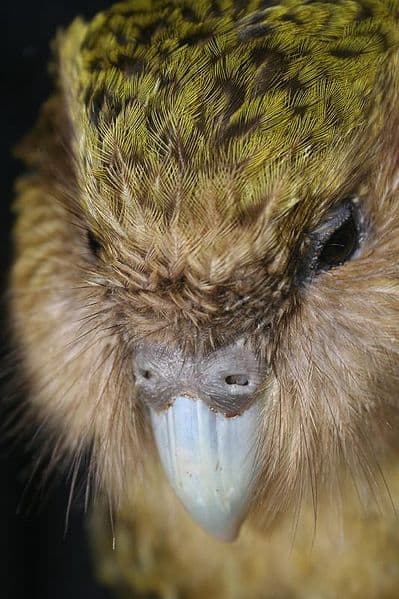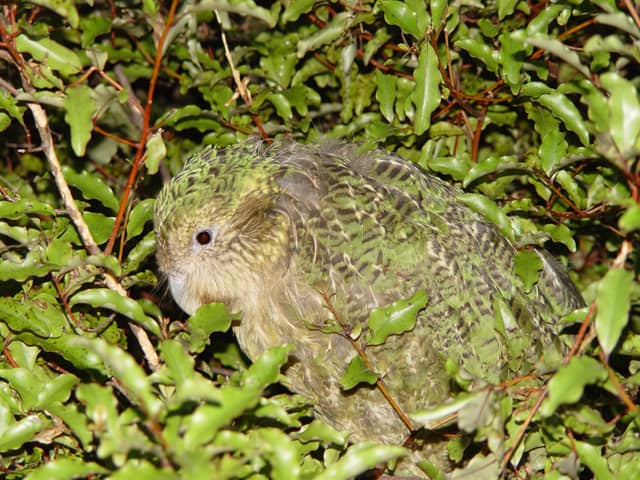Here are 10 incredible Kakapo facts that will probably make you fall in love with this bird. For one, you may not know anything or heard much about New Zealand’s famous flightless parrot. That’s probably because the Kakapo is an extraordinarily rare bird. As such, not many people outside of New Zealand know they exist. And even then, there are so few alive that to see one would be an exception. So, take a trip with us as we explore these fun Kakapo points you should know about.
New Zealand Kakapo – Winged but Flightless
The ground-bound Kakapo is the world’s only flightless parrot. These birds have very short wings that they do not use for flight. Instead, they use their stubby little wings primarily for support and balance. They are adept at jumping from tree to tree, although their foraging is mainly ground-based.
Although they cannot fly, their wings do act as a parachute. This feature affords them a measure of stability in the descent from the tree to the forest floor. Unlike others in the parrot family, Kakapo has soft feathers. These feathers provide protection but are not conducive to flight.
The Fun Facts Behind the Names of the Flightless Parrot
The Kakapo is indigenous to New Zealand. The parrot holds an important place in Māori history and folklore. The name Kakapo is from the Māori word kākāpō, which means “night parrot.”
The Kakapo’s closest relatives are the Kaka and Kea, also native to New Zealand. Their scientific names are Nestor meridionalis for the Kaka and Nestor notabilis for the Kea. The Kakapo has an equally long and complicated name, Strigops habroptilus. All three species belong to the parrot superfamily, Strigopoidea.
The first part of the Kakapos scientific name, Strigops, means “owl-faced” in ancient Greek. The second part, habroptilus, refers to the type of species. Its most accurate translation is “soft feather.”
Kakapo – The Owl-Faced Parrot

Interesting facts about Kakapo are that they are known as the Owl-Parrot of New Zealand and are
endangered
.
On the surface, the Kakapo resembles an owl more than a parrot. Except for its lack of flight, it is entirely parrot, though. Like the owl, the Kakapo has a prominent facial disc. Also, its brown, bristle-like feathers around the eyes, ears, and beak create a rather owl-like aesthetic. As such, the early European settlers aptly named the Kakapo “owl parrot.”
Interestingly, the owl and the Kakapo do share some habits. For example, they are both birds of the night and consequently are more awake and active during the night. This characteristic makes them nocturnal instead of diurnal, meaning active during the day.
Kakapo – Messy Eaters
Unlike the owl, the Kakapo is entirely herbivorous. They feast on plants, fruits, seeds, pollen, flowers, and rhizomes. They are also rather partial to moss and fungi with a side order of bark and sap.
Kakapo also makes quite a mess after eating. But rather than a careless habit, it is with intent. They want their presence to be known. So, when the Kakapo eats, they ingest all the nutritious parts of the plant while discarding the indigestible plant fibers. Leaving this inedible debris is Kakapo’s way of announcing their dining behavior in the area.
Extroverted Socialites
Kakapos are wonderfully playful and engaging birds. They do not shy away from human contact. In fact, they thrive on it! Research reveals that the Kakapo is not afraid of human interaction. Reports on Kakapo behavior show them to be curious animals. Part of their charm is that they have delightfully unique and distinct personalities.
In the early 1800s, the Kakapo was a favorite pet of both Māori and European people. They were said to be docile and doglike in their behavior.
Interesting Kakapo Fact – They’re Almost Human in Nature and Lifespan
There are reports of the Kakapo living up to 90 years old. So not only do they have an almost human way of interacting, but they live as long too. If not, longer! They are one of the longest-living species of birds in the world.
Their lengthy lifespans are primarily due to their slow metabolism. Now, many researchers believe their longevity could be because they live a slow, unhurried life. From maturing to their breeding style, they expend very little energy.
Fun Facts About Kakapo – They Smell Good Too
Kakapos are known for their unique aroma! It may be a strange concept, but the Kakapo gives off a distinct odor. Far from unpleasant, researchers describe it as a sweet, floral, or honey-like smell.
Their sweet-musky odor helps the Kakapo find each other, but it can also be a disadvantage. Unfortunately, their pleasant scent is a siren to a predator. With their delicious smell, they quickly become something’s meal.
Kakapo – Endangered Species
The Kakapo was a thriving species before humans came to New Zealand. However, fossilized data reveals humans, the Kakapo, were common birds in New Zealand.
Kakapos are now critically endangered. Because of the introduction of dogs, cats, and rodents, the Kakapo became the prey. Presently, there are only 215 Kakapo left. Conservation efforts are on the go to improve this number.
Interesting Facts About Kakapo – They’re Hopeless Romantics
The New Zealand Herald shares a fascinating story about the effect of saxophone music on Kakapo breeding rituals. The Department of Conservation and Ngai Tahu asked a renowned saxophonist to compose a romantic tune for the birds. This initiative was designed to raise awareness about these birds.
This quote comes from the endearing article:
“The effect of saxophone music on Kākāpō breeding might not yet be proven. But sometimes you have to think outside the box to save a species. And, with the population currently at 147 birds, the team was willing to give anything a go.”
It must have worked! Since 2019, the number of Kakapo has risen considerably!
Kakapo Fun Facts – This One Might Be a Little Too Friendly!
A hand-raised Kakapo named Sirocco became a mini celebratory in 2009. But unfortunately, his rise to stardom was followed by his attempt to mate with a human zoologist’s head.
Sirocco’s unusual behavior was due to human imprinting rather than his species. So, sadly, his hand-reared lifestyle might lead to a life without offspring. But it does make for an interesting headline, though!
Up Next
The photo featured at the top of this post is © nemethv/Shutterstock.com
FAQs (Frequently Asked Questions)
What is unique about the Kakapo?
The ground-bound Kakapo is the world’s only flightless parrot. These birds have very short wings that they do not use for flight. Instead, they use their stubby little wings primarily for support and balance.
What is a disadvantage of the Kakapo?
Their sweet-musky odor helps the Kakapo find each other, but it can also be a disadvantage. Unfortunately, their pleasant scent is a siren to a predator. With their delicious smell, they quickly become something’s meal.
Thank you for reading! Have some feedback for us? Contact the AZ Animals editorial team.








